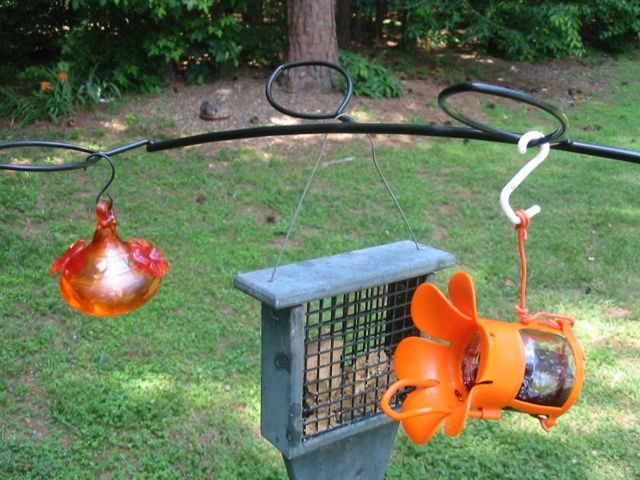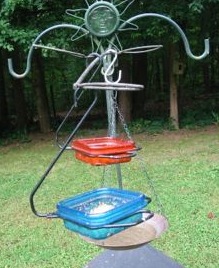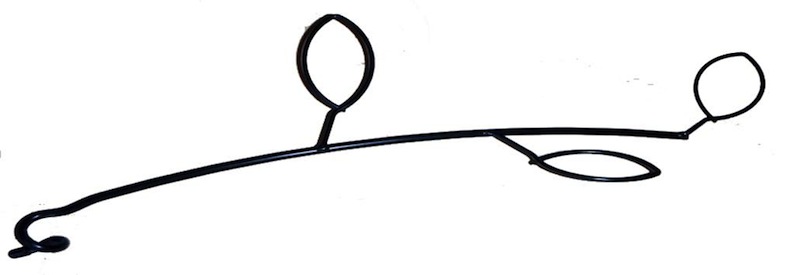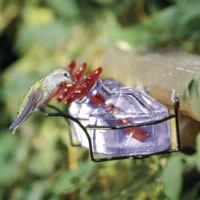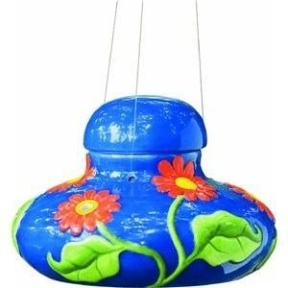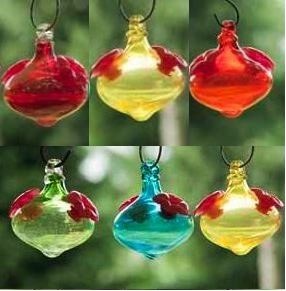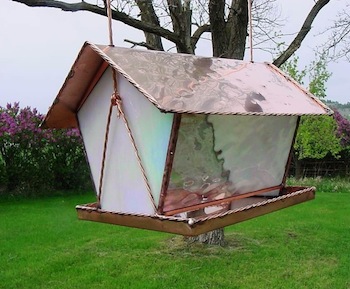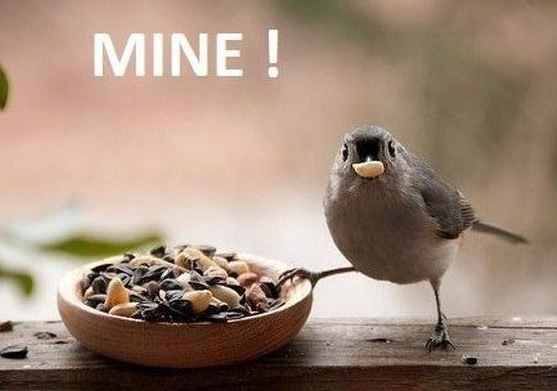-
Groovy bird feeder bracket lets you expand an existing garden pole
You can now add additional feeders or even a small hanging bath without adding another garden pole to the landscape. The simple quick-connect system installs in seconds on any one inch standard garden pole. Made in the USA of heavy duty powder coat steel, this cool bird feeder bracket holds up to ten pounds.
Ideal for adding a suet or hummingbird feeder, mealworm dish, thistle sock, or even a smaller bird bath to entice feathered friends! Since variety is the spice of life, expanding offerings on your existing pole is simple with this bird feeder bracket. It lets you change things up with seasons for maximum bird attraction too. Replace fruit & jelly feeders in winter with whole or shelled peanuts, or consider an extra suet feeder to help resident birds with their need for additional fat and calories during frigid weather.
Measuring two feet in length, the innovative curved branch design with leaves offers several options for placement of any new items. In no time at all, birds will flock to this new pole hanger to check out their new goodies!
-
More eating and less fighting with Bird Brain hummingbird feeders
Their migration south will soon begin as will the “crazies”! Mobs of them, buzzing, fighting, darting around feeders to stake their claim. Tiny bodies need lots of energy for the trek back to winter breeding grounds in Central and South America, and it’s big attitude when it come to fueling up for the trip. Territorial would be an understatement, the sprites can become pretty fierce and downright possessed around feeders!
It’s been a weird season for hummingbirds, many folks report fewer numbers upon their initial arrival, the extended winter weather likely to blame. Fewer (almost none) of the birds’ natural nectar sources were available for their journey northward, possibly causing many to perish. It wasn’t until much later in the season we started seeing more numbers at feeders… and many of them being juveniles.
And soon again it will be time to go – the dwindling hours of daylight is what signals their clocks that it’s time. It’s a total myth that leaving feeders out will keep hummingbirds from leaving… Mother Nature tells them otherwise.
You can really make a difference in helping these flying jewels by offering as much food, and as many sources as possible. If you haven’t done so in the past, try making your own nectar before the season’s over (you’ll be glad you did). It’s really so very simple: 1 cup plain table sugar to 4 cups water… that’s it! Nothing else in the solution as it’s harmful, no red dye needed. We boil one cup of water just to dissolve the sugar more effectively – add 3 cups of cold and no waiting for it to cool. Store unused nectar in the fridge for up to two weeks. Some say the solution may be made stronger during migration as more sugar equals more fuel. Never stronger than a 1:3 ratio though.
Keep nectar fresh and consider hanging an
extra feeder or two so there’s not so much fussing and fighting. Multi-port styles are a good idea as they allow more birds to feed at once… provided they can all get along!
Most of the Bird Brain Hummingbird Feeders offer 2-3 ports and some of them are still around. In fact, they’re being manufactured again under a different name – so they must be worth it! The Mini-kins are perfect for this time of year because they come in a set of three and may be placed in separate locations. Again… less fussing and more eating will suit hummingbirds best for their long trip ahead!
-
glass bird feeder is built to last
Although wood is good for birdhouses, it’s not always best for feeders because squirrels chew wood! Over time wood will weather, sometimes nicely-sometimes not depending on the quality. Wood is porous and therefore harbors bacteria and mold… not good for birds. Copper, glass, or recycled plastic provides a slick surface that’s more resistant to bacteria, much easier to clean and way better for the birds.
A stained glass bird feeder like this hopper model allows for various seed mixes. It won’t ever fade, warp or rust, and it’s chew-proof by squirrels. Handcrafted in the USA, it’s available in about eight different colors, and features a hand hammered copper roof.
What’s the best kind feeder to get when starting out? It’s simply got to be the one you will maintain. Basic black oil sunflower is a popular seed that many species enjoy. If you don’t care for the hulls or mess below feeders – opt for sunflower hearts or a “no-waste” mix. These cost a little more, but every morsel is consumed, no messy ground waste below feeders! Cheap seed with fillers (like milo and millet) will end up on the ground, and in damp or humid conditions, creates another breeding ground for bacteria and mold. Ground feeding birds like cardinals, towhees and juncos will sift through this junk looking for a bite to eat. Yuck!
If the only feeder you’re up to maintaining is a simple bowl, that’s okay too. Just keep it clean and keep food fresh… and they wi
ll come! And don’t forget to add a water source, a shallow bowl or plant saucer with fresh water creates a refuge on hot summer days!

